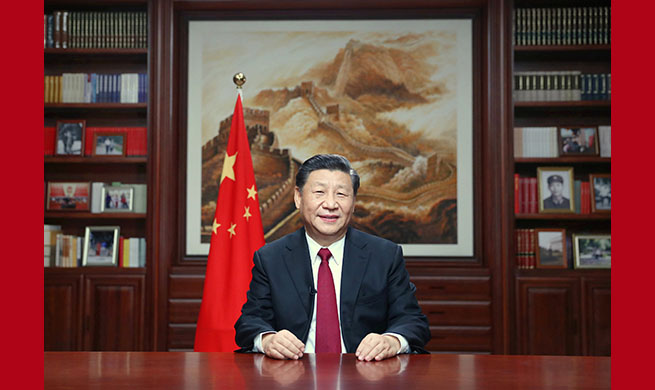BEIJING, Jan. 3 (Xinhua) -- China's lunar rover Yutu-2 has driven 357.695 meters on the far side of the moon to conduct scientific exploration of the virgin territory.
Both the lander and the rover of the Chang'e-4 probe have ended their work for the 13th lunar day on Thursday (Beijing time), and switched to dormant mode for the lunar night, according to the Lunar Exploration and Space Program Center of the China National Space Administration.
The scientific instruments on the lander and rover worked as planned. The rover conducted explorations of several sites and photographed and conducted an infrared detection of a stone on the lunar surface, said the center.
China's Chang'e-4 probe, launched on Dec. 8, 2018, made the first-ever soft landing on the Von Karman Crater in the South Pole-Aitken Basin on the far side of the moon on Jan. 3, 2019.
Friday marks the one-year anniversary of the lunar landing of the Chang'e-4 probe.
The landing site of the probe has been named "Statio Tianhe." "Tianhe" is the Chinese word for the Milky Way and "Statio" is Latin for base.
Yutu-2, or Jade Rabbit-2, has worked much longer than its three-month design life, becoming the longest-working lunar rover on the moon.
The rover has found materials from deep inside the moon that could help unravel the mystery of the lunar mantle's composition and the formation and evolution of the moon and the earth.
Using data obtained by the visible and near-infrared spectrometer installed on Yutu-2, Chinese scientists found that the lunar soil in the landing area of the Chang'e-4 probe contains olivine and pyroxene which came from the lunar mantle deep inside the moon.
Due to the complicated geological environment and the rugged and heavily cratered terrain on the far side of the moon, the rover drives slowly but steadily and is expected to continue traveling on the moon and make more scientific discoveries.
In order to provide a communication link between the far side of the moon and the ground control, China sent the relay satellite Queqiao, or Magpie Bridge, into the halo orbit around the second Lagrangian point of the earth-moon system, nearly 500,000 km from the earth.
Zhang Lihua, chief designer of Queqiao, said the satellite has been working well and is able to continue its operation for another 10 years.
"We will let Queqiao work as long as possible. It could also provide communication for probes from other countries if they intend to explore the moon's far side within the lifetime of the satellite," Ye Peijian, an academician of the Chinese Academy of Sciences and a senior space expert, said earlier.

















